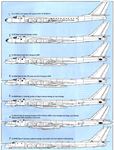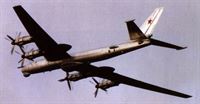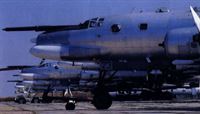Фотографии
-
Although seen here under a Tu-160 Blackjack, the Kh-55SM AS-15 Mod B long-range version of the Kent ALCM is also carried by the Tu-95MS on the MKU-6-5 rotary launcher in the aircraft’s bomb bay. The missile has a 200kt nuclear warhead, cruises at a speed of M0.48 to M0.77 at between 130-360ft, powered by a TRDD-50 by-pass turbojet and has a range of 1,620nm. This engine can just be seen in its deployed position, at the rear of the missile. The AS-15 Mod A version has a range of 1,350nm.
Самолёты на фотографии: Туполев Ту-160 - Россия - 1981
-
Russia's strategic bomber force has used the names of major cities for the Tu-95MS, and one of the first to be so honoured was named for the city of Saratov, whose coat-of-arms it bears under the cockpit. The city has a long association with Engels and with Russia's military traditions. Note also the pale blue leading edge of the fin of Red 10, a procedure traditionally adopted to designate the squadron commander’s aircraft. The significance of the numerous white panels around the engine nacelles is not known.
Самолёты на фотографии: Туполев Ту-95МС - Россия - 1979
-
Bear-Hs which remained in the Ukraine following the collapse of the Soviet Union were stripped of all their Russian Air Force identity, although the location of the red stars was still evident on most. The lead aircraft in this line-up at Uzin was the only one to be decorated with the blue and yellow Ukrainian 'diving falcon' symbol. These aircraft were either transferred to Engels, near Saratov, in Russia, or were broken up in accordance with treaty obligations.
Самолёты на фотографии: Туполев Ту-95МС - Россия - 1979
-
This close-up of the nose of Tu-95MS Red 15 at Engels AB, named in honour of the city of Kaluga, shows detail of the forward antenna locations of the Bear-H. The large white chin radome houses the antenna of the Clam Pipe nav-attack radar, with ECM antennae above it. Underneath the main radome is the Mak (Poppy) missile approach warner, with a red protective cover over its delicate optical sensors. In front of this is the forward hemisphere jamming antenna of the aircraft’s terrain bounce ECM system. A similar antenna provides jamming cover in the rear hemisphere. The external waveguide fairing under the aircraft’s name connects the Clam Pipe antenna with processing units in the cabin.
Самолёты на фотографии: Туполев Ту-95МС - Россия - 1979
-
1. Tu-114D/Tu-116 special VIP variant of the Tu-95 Bear-A. 2. Tu-95 Bear-A free fall bomber variant. 3. Tu-95K Bear-B with AS-3 Kangaroo ASM. 4. Tu-95KD Bear-B with IFR probe and AS-3 Kangaroo ASM. 5. Tu-95KM Bear-C showing location of Sigint antenna fairings on rear fuselage. 6. Tu-95K-22 Bear-G showing location of AS-4 Kitchen ASMs under fuselage and wings, plus Rezeda (Mignonette) ECM installation in tail cone. 7. Tu-95MS Bear-H showing modified fuselage nose profile and more angular cockpit glazing
Самолёты на фотографии: Туполев Ту-116 - Россия - 1957Туполев Ту-95 / Ту-95М - Россия - 1952Туполев Ту-95К - Россия - 1956Туполев Ту-95МС - Россия - 1979
-
Seen at Ryazan Air Base in October 1992, this Tu-95MR Bear-E was used in the latter years of its service for a variety of utility tasks, including unspecified ‘technical improvement trials’. The two tear-drop antennae under the forward fuselage are part of the Romb Elint suite, whilst the red band around the rear fuselage denotes its non-combative status within the provisions of Article XI of the START-1 Treaty.
Самолёты на фотографии: Туполев Ту-95 / Ту-95М - Россия - 1952
-
One of only four Tu-95MRs ever built being broken up at Ryazan in 1992. Noteworthy on the aircraft's tail unit control surfaces are the presence of comparatively small tailplane trim tabs. The fairing behind the red band on the fuselage is part of the aircraft’s Vishnya (Cherry Tree) communications intelligence gathering equipment.
Самолёты на фотографии: Туполев Ту-95 / Ту-95М - Россия - 1952
-
A sight epitomising the Cold War stand-off between East and West as a Royal Air Force McDonnell Douglas Phantom FG.I of 111 Squadron escorts a Soviet Naval Air Force Tu-95RTs Bear-D in international airspace off the north of Scotland in the mid-1980s. Note the Phantom's enlarged roundel, applied for the year's airshow appearances, probably around 1985. The Bear-D was a participant in a large-scale Soviet naval exercise.
Самолёты на фотографии: McDonnell Douglas Phantom FG.Mk I / FGR.Mk II - США - 1964Туполев Ту-95РЦ - Россия - 1965
-
The principal characteristics of the Bear-D are clearly visible in this rear underside view. Prominent under the central fuselage is the large radome of the aptly-named Big Bulge search radar, with the smaller Shorthorn antenna under the nose. The fairing on the rear fuselage is one of a pair feeding the aircraft’s contingency Sigint suite, whilst the cigar-shaped antennae on the tailplane tips are part of the Arfa (Harp) missile-guidance data relay system.
Самолёты на фотографии: Туполев Ту-95РЦ - Россия - 1965
-
One of the 65 Tu-95K-22 Bear-Gs prepared for inspection after dismantling in the ‘reduction zone’ of the START-1-monitored 6213th BLAT (Baza Likvidatsii Avia-Tekhniki) aircraft disposal base at Engels in 1997. Visible on the fuselage in line with the rear of the nosewheel door is one of the four grey cigar-shaped data-link antennas of the Kurs (Course) guidance system for the AS-4 Kitchen air-launched cruise missiles. The Bear-G could carry a total of three AS-4s, one on each wing pylon and one semi-recessed under the central fuselage area.
Самолёты на фотографии: Туполев Ту-95К - Россия - 1956
-
Five Tu-95K-22s lined up at Engels during the initial stage of dismantling in accordance with the obligations of START-1 (Strategic Arms Reduction Talks). Clearly visible is the forward hemisphere jamming antenna of the SPS-141 ECM system protruding above the radome of the PNA-B (Downbeat) radar. Also visible on most of the aircraft are the Kurs data-link antennae in their forward and rear locations on the fuselage. The item visible between the aircraft is the jib of a mobile crane supplied by P & H Equipment of Austin, Texas, contracted to support the dismantling process.
Самолёты на фотографии: Туполев Ту-95К - Россия - 1956
Статьи
- -
- Airscene
- Talkback
- ??? - QinetiQ. Dynamic in Name and Nature /Industry/
- A.Dawes - Nimrod MRA.4 /Military/
- A.Dawes - Tupolev's Bear /Military/ (2)
- B.Perrett - Sonic Cruiser /Commercial/
- B.Walters - Taking the road to recovery /Commercial/
- D.Marshall - SBAC. The way ahead /Industry/
- I.Goold - A Tale of Two Industries /Commercial/
- J.Cook - Aviator or Flight Manager? /Technology/
- J.Lake - Eurocopter EC 135 /Rotary wing/
- J.Lake - Westland Super Lynx /Military/
- R.Gardner - Aerospace in the UK /Industry/
- R.Hewson - Airbus A380. Europe's giant giant-killer /Commercial/
- R.Hewson - JSF UK. More than just aircraft /Military/










